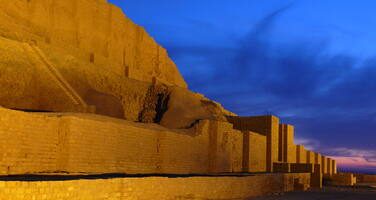Tchogha Zanbil
Factors affecting the property in 1995*
- Management activities
- Water (rain/water table)
- Other Threats:
absence of a viable method for sustainable conservation of the mud-brick structures; structural problems
International Assistance: requests for the property until 1995
Total amount approved : 6,667 USD
| 1986 | Purchase of photogrammetric equipment for the Iranian ... (Approved) | 6,667 USD |
Missions to the property until 1995**
Information presented to the Bureau of the World Heritage Committee in 1995
The first joint Japan/UNESCO project identification mission to this World Heritage Site inscribed in 1979, which took place in February 1995, observed that in spite of the application of a good traditional method of conservation, consisting of covering the exposed structures each year with "kargel" (mud and straw mixture), the site has continued to deteriorate in the absence of a viable method for sustainable conservation of the mud-brick structures which are annually exposed to heavy rainfall.
The mission also noted some movement of the supporting brick walls of the Ziggurat, pointing to the probability of structural problems.
The Physical Heritage Division of UNESCO urges the deployment of a second technical team including a structural engineer to define better the scope of the conservation measures required and to finalize the project document for submission to funding sources.
Action Required
The Bureau requests the Iran authorities to inform the Committee on the state of conservation of Tchogha Zanbil through the procedures established for systematic monitoring and reporting.
Summary of the interventions
Decisions adopted by the Committee in 1995
19 BUR VI.22
Tchogha Zanbil (Iran)
The Centre informed the Bureau that a joint Japan/UNESCO project identification mission to this World Heritage Site inscribed in 1979, took place in February 1995. It was observed that in spite of the application of a good traditional method of conservation, consisting of covering the exposed structures each year with "kargel" (mud and straw mixture) , the site has continued to deteriorate in the absence of a viable method for sustainable conservation of the mud-brick structures which are annually exposed to heavy rainfall.
The mission also noted some movement of the supporting brick walls of the Ziggurat, pointing to the probability of structural problems.
It was reported that the Physical Heritage Division of UNESCO is currently urging the deployment of a second technical team including a structural engineer to define better the scope of the conservation measures required and to finalize the project document for submission to funding sources.
The Centre informed the Bureau that the Iranian cultural authorities have invited international experts to participate in the preparation of their monitoring reports on the occasion of the forthcoming regional conference for West and Central Asian experts being organized jointly by ICCROM and the Iranian Central Research Laboratory for Conservation of Cultural Heritage.
The Bureau noted the invitation by the Iranian authorities for international experts to participate in the preparation of their systematic monitoring report and suggested that the Iranian authorities inform the Committee at its nineteenth session on the state of conservation of this property.
Exports
* :
The threats indicated are listed in alphabetical order; their order does not constitute a classification according to the importance of their impact on the property.
Furthermore, they are presented irrespective of the type of threat faced by the property, i.e. with specific and proven imminent danger (“ascertained danger”) or with threats which could have deleterious effects on the property’s Outstanding Universal Value (“potential danger”).
** : All mission reports are not always available electronically.


